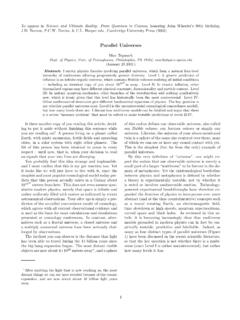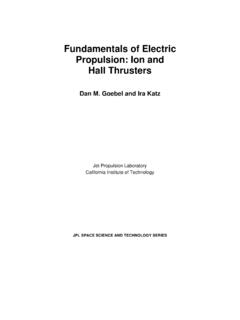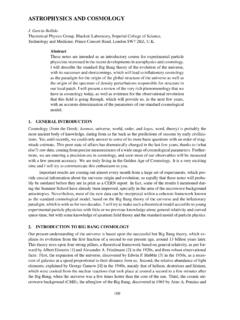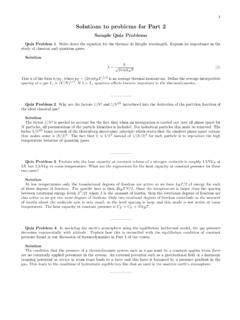Transcription of Galaxies through Space and Time - NASA
1 Galaxies through Space and Time2 ContentsINTRODUCTION 4 About the Hubble Space Telescope 5 Our Understanding of Galaxies : A Timeline 7 CHAPTER 1: Our Galactic Neighborhood 10 Seeking the Source of Falling Gas ..12 Studying Ancient Stars in the Milky Way ..14 Tracing the Origin of an Intergalactic Cloud ..16 Surveying Star Clusters in the Andromeda Galaxy ..17 Measuring a Giant Halo around the Andromeda Galaxy ..19 CHAPTER 2: Intriguing Galaxies across the Universe 20 Excavating a Prehistoric Galaxy in Our cosmic Backyard.
2 22 Witnessing a Rash of Star Formation in Long-Quiet Dwarf Galaxies ..23 Investigating New Star Birth in a Tiny Tadpole Galaxy ..25 Seeing Star Formation in Elliptical Galaxies ..27 Finding a Relic Galaxy Close to Home ..29 Identifying the Spark that Ignites Quasars ..31 Detecting a Double Black Hole ..32 CHAPTER 3: The Farthest Galaxies 34 Discovering a Distant Dead Disk Galaxy ..36 Detailing the Universe s Brightest Infrared Galaxies ..37 Uncovering a Stretched-Out Galaxy from the Very Early Universe ..39 Spotting the Faintest Galaxy Yet Seen in the Distant Universe ..40 Pushing the Limits of Our cosmic View ..42 SUMMARY 43 MORE INFORMATION 44 CREDITS 45 This deep Hubble image captures many of the hundreds of Galaxies that belong to the massive galaxy cluster Abell 2744, located billion light-years from Earth.
3 In the background are small, faint Galaxies that lie even farther in the distance, some more than 12 billion light-years : NASA, ESA, and J. Lotz, M. Mountain, A. Koekemoer, and the Hubble Frontier Fields Team (STScI)34 INTRODUCTIONThis e-book is part of a series called Hubble Focus. Each book will present some of Hubble s more recent and important observations within a particular topic. The subjects will span from our nearby solar system out to the horizon of Hubble s observable book, Hubble Focus: Galaxies through Space and Time, highlights some of Hubble s recent discoveries about the homes of stars, nebulas, and planets: Galaxies from our very own galaxy, the Milky Way, to the most distant Galaxies anyone has ever seen. Hubble s recent contributions are often in partnership with other Space telescopes as well as those on the ground, and build on decades of discoveries that came before Hubble s launch.
4 Its findings are helping us understand how our universe has come to be the way it is with new star formation, spiral galaxy NGC 6744 is similar in shape to our Milky Way galaxy but is more than double the : NASA, ESA, and the Legacy ExtraGalactic UV Survey (LEGUS) team5 About the Hubble Space TelescopeSince its launch in 1990, NASA s Hubble Space Telescope has made more than one million observations, amassed a huge archive of scientific findings, and had a profound effect on all areas of observational astronomy. Hubble has addressed fundamental cosmic questions and explored far beyond the most ambitious plans of its builders. It has discovered that Galaxies evolve from smaller structures, found that supermassive black holes are common at the centers of Galaxies , verified that the universe s expansion is accelerating, probed the birthplaces of stars inside colorful nebulas, analyzed the atmospheres of extrasolar planets, and supported interplanetary missions.
5 The rate of discovery with Hubble is simply unparalleled for any telescope in the history of astronomy. Hubble observes the universe from Earth orbit, just outside our planet s : NASAAs NASA s first Great Observatory and the first major optical telescope in Space , Hubble ushered in a new era of precision astronomy. The heart of the telescope is its primary mirror. It is the smoothest optical mirror ever polished, with no deviations greater than one-millionth of an inch. Operating above Earth, free from the blurring and filtering effects of our planet s atmosphere, Hubble can resolve astronomical objects ten to twenty times better than typically possible with large ground-based telescopes. It also can observe those objects across a range of the electromagnetic spectrum, from ultraviolet light through visible and to near-infrared can detect objects as faint as 31st magnitude, which is about 10 billion times fainter than the human eye can see.
6 The telescope can see faint objects near bright objects an important requirement for studying the regions around stars and close to the glowing nuclei of active Galaxies . Astronomers have used Hubble s sharp vision to probe the limits of the visible universe, uncovering never-before-seen objects that existed not long after the birth of the universe in the Big Bang. Hubble s view is optically stable, meaning the quality of its observing conditions never changes from day to day or even orbit to orbit. Hubble can revisit celestial targets with the same acuity and image quality over and over again. This is crucial for precision observations in which astronomers try to detect small changes in the light, motion, or other behavior of a celestial is more technologically advanced now than it was when launched, thanks to the maintenance and upgrades provided by five Space shuttle servicing missions between 1993 and 2009.
7 Hubble is expected to continue operating well beyond John Grunsfeld and Andrew Feustel replace a Fine Guidance Sensor on Hubble during the last servicing mission in May : NASA7 Our Understanding of Galaxies : A TimelineGalaxies are cosmic islands of stars, planets, nebulas, gas, dust, and dark matter that are separated from one another in Space but collectively help to tell the story of the universe. With the Hubble Space Telescope, we have begun to understand Galaxies as time capsules that chronicle how the universe evolved, from the birth of stars within them to the buildup of immense galaxy clusters. However, this modern realization of the cosmic role and significance of Galaxies , including our own, took centuries to scientist Galileo Galilei uses a newly invented instrument the telescope to resolve the band of light running across the night sky, known as the Milky Way, into myriad stars that he presumes must be at a great astronomer Thomas Wright speculates that some fuzzy patches in the night sky called nebulae (or nebulas) are external Galaxies like the Milky Way, far beyond our comet-hunter Charles Messier publishes the first version of his catalog of non-stellar objects, which eventually includes over three dozen Galaxies even though he has no idea of their nature or great Parsons, Ireland s third Earl of Rosse, uses the world s largest telescope of the time to resolve spiral nebulae such as M51 (known today as the Whirlpool galaxy)
8 Astronomers largely assume it is a nearby whirlpool of gas because no stars can be the Great Debate, held before a public audience in Washington, DC, astronomers Harlow Shapley and Heber Curtis argue whether spiral nebulae are part of our galaxy or outside of astronomer Edwin Hubble publishes a paper demonstrating that M31, known then as the Andromeda Nebula, lies far outside our own galaxy. He later develops an evolutionary sequence of galaxy types in an attempt to organize his observations. Hubble also uses Galaxies as markers of Space to measure the expansion rate, and hence the age, of the of galaxy motion (building on earlier studies of stellar motion) provide evidence that an invisible form of matter, later dubbed dark matter, dominates the universe. Galaxies contain only a small fraction of the mass in the discovery of the cosmic microwave background provides observational evidence for the Big Bang hypothesis.
9 This means that Galaxies must have evolved from a hot and dense Vera Rubin and Kent Ford confirm the existence and dominance of dark matter in Galaxies by measuring the motions of stars s cosmic background Explorer (COBE) reveals minor temperature fluctuations in the early universe that led to the amalgamation of matter and the formation of early confirms the existence of a supermassive black hole in the core of galaxy M87. Subsequent Hubble surveys find that such black holes are common to Galaxies and that a black hole s mass correlates with the mass of its parent Hubble Deep Field finds thousands of Galaxies , including many very distant ones, in a comparatively blank-looking patch of imaging from Hubble definitively shows that brilliant objects known as quasars are located at the cores of faint, distant Galaxies . Many quasar host Galaxies interact with neighboring Galaxies , which fuels activity near supermassive black holes at galactic of supernovas in distant Galaxies show that the expanding universe is accelerating.
10 Astrophysicists hypothesize that this is caused by an unknown form of energy, labeled dark energy, that permeates all of Space , pushing the Galaxies farther apart at an ever-increasing rate. 2003 NASA s Wilkinson microwave Anisotropy Probe (WMAP) produces an even higher-quality map of the cosmic microwave background showing fine structure in the early universe, which led to the distribution of mass and Galaxies observed in the universe ten-year compilation of observations allows astronomers to assemble the most comprehensive picture of the evolving universe, spanning ultraviolet to near-infrared wavelengths, in a small patch of sky known as the Hubble Ultra Deep image of the Hubble Ultra Deep Field, released in 2014, is a colorful and comprehensive view of the evolving universe, capturing approximately 10,000 Galaxies seen across Space and time.














